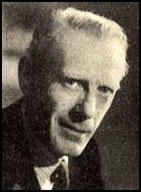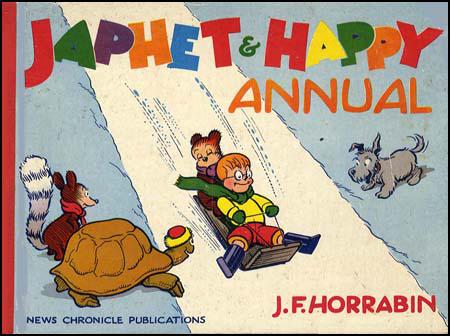Frank Horrabin

James Francis Horrabin, the eldest son of James Woodhouse Horrabin, a cutler from Sheffield, was born at 12 Cromwell Road, Peterborough, on 1st November 1884. Horrabin attended Stamford Grammar School and the Sheffield School of Art, where he studied metalwork design.
A talented cartoonist, Horrabin joined the staff of the Sheffield Telegraph in 1906. Three years later he became art editor for the Yorkshire Telegraph & Star. On 11th August 1911 he married Winifred Batho, and in the same year he moved to London to work on the Daily News where he created the cartoon character of Japhet Noah.
Horrabin was a socialist and he became a member of the Fabian Society and the Plebs' League. Horrabin became a Guild Socialist in 1915 and dedicated his artistic talent to working-class politics. This included cartoons for left-wing journals such as The Plebs. His biographer, Margaret Cole, has argued: "For these visual works of polemic, Horrabin relied upon a greater realism of style. His political caricatures were clear portraits, and the gentle humour of the Noahs was replaced by bitter and dark jest."
Horrabin lectured in the Central Labour College and joined with his wife in founding the Central Labour College's Women's League in 1913 to promote the education of women workers. The couple were also active in the women's suffrage campaign.
During the First World War Horrabin served on the Western Front with Queen's Westminster Rifles. On his return he went to work for the News Chronicle. Horrabin became friendly with H. G. Wells and in 1919 illustrated his book, Outline of History. His 200-plus contributions included maps and charts and speculative reconstructions of prehistoric animal and plant life. Wells said of Horrabin that he was "not only an illustrator but a collaborator".
In 1920 Horrabin became a founder member of the Communist Party of Great Britain. Other early members included Tom Bell, Willie Paul, Arthur McManus, Harry Pollitt, Rajani Palme Dutt, Helen Crawfurd, A. J. Cook, Albert Inkpin, J. T. Murphy, Arthur Horner, Tom Mann, John R. Campbell, Bob Stewart, Shapurji Saklatvala, William Mellor, George Aitken, Sylvia Pankhurst and Robin Page Arnot.
Some of Frank Horrabin's cartoons in the News Chronicle were so popular that they appeared in several books including Japhet and Fido (1922), Mr Noah (1922), More about the Noahs (1922), and The Japhet Book (1925). Mark Bryant has argued: "He (Horrabin) is perhaps best known for the strip Dot and Carrie which ran for nearly 12,000 episodes in the Star (appearing on the same page as the political cartoon by David Low) and then the Evening News. Began in 1922 and originally written by his brother-in-law, H.O. Botho, it featured two typists, pretty blonde Dorothy and dark bespectacled Caroline, their grumpy boss Mt Spilliken, the office boy Aldolphus and the charlady, Mrs Mopps."

Frank Horrabin also co-wrote Working Class Education (1924) with Winifred Horrabin. During this period he began an extramarital affair with Ellen Wilkinson. Horrabin was an active supporter of the 1926 General Strike and afterwards he was co-author with Wilkinson and Raymond Postgate of The Workers History of the Great Strike (1927).
In the 1929 General Election Horrabin was elected to the House of Commons as the representative of Peterborough. Horrabin was an opponent of Ramsay MacDonald and his National Government and like most Labour members he lost his seat in the 1931 General Election.
Horrabin became close to Stafford Cripps, the leader of the left-wing of the Labour Party. Other members of this group included Aneurin Bevan, Ellen Wilkinson, Frank Wise, Jennie Lee, Harold Laski, William Mellor, Barbara Betts and G. D. H. Cole. In 1932 the group established the Socialist League. Horrabin also joined the executive of the Society for Socialist Inquiry and Propaganda and took on the editorship of The Socialist and Socialist Leaguer.
With the rise of Adolf Hitler in Nazi Germany, Horrabin became convinced that the Labour Party should establish a United Front against fascism with the Communist Party of Great Britain and the Independent Labour Party. In April 1934 William Mellor had a meeting with Fenner Brockway and Jimmy Maxton, two leaders of the ILP, "to talk over ways and means of securing working-class unity". He also had meetings with Harry Pollitt, the General Secretary of the Communist Party of Great Britain.
After the outbreak of the Second World War Horrabin became more interested in international socialism and became active in the Fabian Commonwealth Bureau, providing it with Empire, a monthly anti-imperialist journal. He also wrote a regular column for the monthly Socialist Commentary.
Horrabin's first marriage to Winifred Batho was dissolved in 1947. On 30 March 1948 he married Margaret Victoria McWilliams, a widow, with whom he had been conducting an extramarital affair since his relationship with Ellen Wilkinson.
Frank Horrabin died of bronchopneumonia at his home, 16 Endersleigh Gardens, Hendon, on 2nd March 1962.
